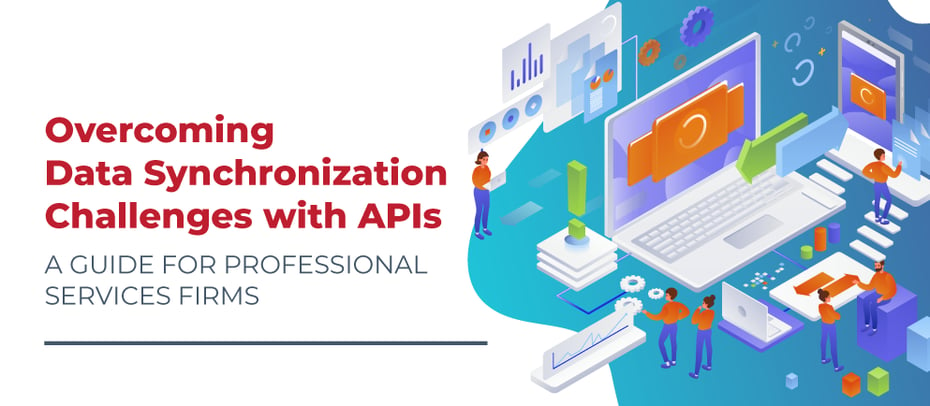Overcoming Data Synchronization Challenges with APIs: A Guide for Professional Services Firms

In today's fast-paced business environment, organizations such as professional services firms rely on data synchronization between systems to ensure consistency and accuracy across different departments and teams. Getting this data from one system to another will require the use of an API. In this blog, we will explore the basics of APIs and how they play a crucial role in connecting systems for seamless data exchange.
Here, also, we will discuss common pitfalls that organizations like professional services firms may face during the synchronization process. These include data mapping errors, lack of standardization, security concerns, and network reliability issues. So, let's dive into the world of APIs and learn how they can revolutionize your organization's data synchronization process!
Why Synchronize Systems?
Well, organizations such as professional services firms synchronize data between systems to ensure that the same data is available in multiple locations or systems. This can provide several benefits, including:
- Improved data accuracy: Synchronizing data between systems helps ensure that data is consistent and up to date across all systems. This can reduce errors and improve overall data accuracy.
- Improved efficiency: When data is synchronized between systems, it can reduce the amount of manual data entry required. This can save time and improve overall efficiency.
- Better decision-making: Synchronized data can help ensure that decision-makers have access to the most accurate and up-to-date information across all systems. This can improve the quality of decision-making and lead to better outcomes.
- Better collaboration: When data is synchronized between systems, it can improve collaboration between teams or departments. This can help ensure that everyone has access to the same information and reduce misunderstandings or conflicts that can arise from using different data.
- Data backup and recovery: Synchronizing data between systems can also help ensure that data is backed up and can be recovered in the event of a system failure or disaster. This can help organizations avoid data loss and minimize downtime.
What is an API?
This acronym that has been tossed around stands for Application Programming Interface. It is a set of protocols, routines, and tools for building software applications. An API specifies how software components should interact with each other, allowing different systems to communicate and exchange data seamlessly. In the realm of intersystem connectivity, an API functions like a door into an application for programming to perform automated routines.
What are Endpoints and Methods?
Let’s break down APIs even further:
API Endpoints
An API endpoint is a unique URL where a client can access a specific resource or perform a specific action within an API. In other words, it is the location where an API can be accessed over the internet. Endpoints are defined by the API provider and are usually documented for developers to know how to interact with the API. For example, if an API provides access to a list of products, the endpoint might be something like https://api.example.com/products.
When an application/client sends a request to an endpoint, the API will process the request and send back a response containing the requested data or action. The response will usually be in a specific data format, such as JSON or XML, which the client can then process and use in their application.
API endpoints are an essential part of building a RESTful API (Representational State Transfer), which is a common architecture style for building web APIs. They provide a clear and consistent way for clients to interact with an API and perform actions on specific resources.
API Methods
API methods, also known as HTTP methods or verbs, are the different types of requests that can be made to an API endpoint. Each method represents a different type of action that can be performed on a resource. The most common API methods are:
- GET: retrieves data from an API endpoint. This is the most common API method and is used to retrieve data like user profiles, product listings, and other resources.
- POST: submits data to an API endpoint to create or update a resource. This method is used to create new resources or update existing ones, like submitting a form or creating a new blog post.
- PUT: updates an existing resource with new data. This method is used to update an existing resource, like updating a user's profile information.
- DELETE: deletes a resource from an API endpoint. This method is used to delete a resource, like deleting a user account.
- PATCH: updates part of an existing resource with new data. This method is used to update a specific part of a resource, like changing a user's email address.
API methods are typically used in conjunction with API endpoints to perform specific actions on resources. The appropriate method to use will depend on the type of action being performed and the resource being accessed.
Revolutionize Data Synchronization with APIs
With this quick introduction, you should hopefully now understand how APIs can revolutionize your organization's data synchronization process. Scoping an API integration project between any two systems requires careful planning, clear communication, and a focus on delivering business value. By following these best practices, organizations like professional services firms can increase the likelihood of a successful integration project and achieve their desired outcomes.




